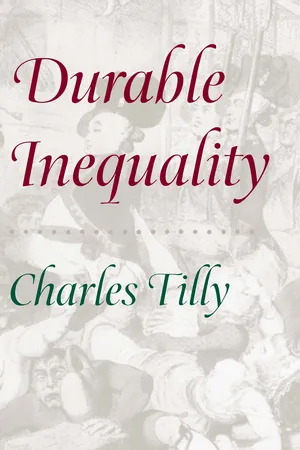eBook - PDF
Durable Inequality
About this book
Charles Tilly, in this eloquent manifesto, presents a powerful new approach to the study of persistent social inequality. How, he asks, do long-lasting, systematic inequalities in life chances arise, and how do they come to distinguish members of different socially defined categories of persons? Exploring representative paired and unequal categories, such as male/female, black/white, and citizen/noncitizen, Tilly argues that the basic causes of these and similar inequalities greatly resemble one another. In contrast to contemporary analyses that explain inequality case by case, this account is one of process. Categorical distinctions arise, Tilly says, because they offer a solution to pressing organizational problems. Whatever the "organization" is—as small as a household or as large as a government—the resulting relationship of inequality persists because parties on both sides of the categorical divide come to depend on that solution, despite its drawbacks. Tilly illustrates the social mechanisms that create and maintain paired and unequal categories with a rich variety of cases, mapping out fertile territories for future relational study of durable inequality.
Frequently asked questions
Yes, you can cancel anytime from the Subscription tab in your account settings on the Perlego website. Your subscription will stay active until the end of your current billing period. Learn how to cancel your subscription.
At the moment all of our mobile-responsive ePub books are available to download via the app. Most of our PDFs are also available to download and we're working on making the final remaining ones downloadable now. Learn more here.
Perlego offers two plans: Essential and Complete
- Essential is ideal for learners and professionals who enjoy exploring a wide range of subjects. Access the Essential Library with 800,000+ trusted titles and best-sellers across business, personal growth, and the humanities. Includes unlimited reading time and Standard Read Aloud voice.
- Complete: Perfect for advanced learners and researchers needing full, unrestricted access. Unlock 1.4M+ books across hundreds of subjects, including academic and specialized titles. The Complete Plan also includes advanced features like Premium Read Aloud and Research Assistant.
We are an online textbook subscription service, where you can get access to an entire online library for less than the price of a single book per month. With over 1 million books across 1000+ topics, we’ve got you covered! Learn more here.
Look out for the read-aloud symbol on your next book to see if you can listen to it. The read-aloud tool reads text aloud for you, highlighting the text as it is being read. You can pause it, speed it up and slow it down. Learn more here.
Yes! You can use the Perlego app on both iOS or Android devices to read anytime, anywhere — even offline. Perfect for commutes or when you’re on the go.
Please note we cannot support devices running on iOS 13 and Android 7 or earlier. Learn more about using the app.
Please note we cannot support devices running on iOS 13 and Android 7 or earlier. Learn more about using the app.
Yes, you can access Durable Inequality by Charles Tilly in PDF and/or ePUB format, as well as other popular books in Social Sciences & Discrimination & Race Relations. We have over one million books available in our catalogue for you to explore.
Information
/
Of
Essences
and
Bonds
We
could
reasonably
call
James
Gillray
(1757-1815)
Britain's
first
profes-
sional
cartoonist
(George
1967,
57;
Hill
1976).
He
left
us
unforgettable
images
of
public
and
private
affairs
under
George
III.
Very
few
hand-
some
people
figure
in
Gillray's
caricatures.
In
the
savage
portrayals
of
British
life
he
drew,
etched,
and
colored
toward
1800,
beefy,
red-faced
aristocrats
commonly
tower
over
other
people,
while
paupers
almost
invariably
appear
as
small,
gaunt,
and
gnarled.
If
Gillray
painted
his
compatriots
with
malice,
however,
he
also
observed
them
acutely
Take
the
matter
of
height.
Let
us
consider
fourteen-year-old
entrants
to
the
Royal
Military
Academy
at
Sandhurst
to
represent
the
healthier
portion
of
the
aristocracy
and
gentry,
and
fourteen-year-old
recruits
for
naval
service
via
London's
Marine
Society
to
represent
the
healthier
por-
tion
of
the
city's
jobless
poor.
At
the
nineteenth
century's
start,
poor
boys
of
fourteen
averaged
only
4
feet
3
inches
tall,
while
aristocrats
and
gentry
of
the
same
age
averaged
about
5
feet
i
inch
(Floud,
Wachter,
and
1
Table of contents
- Cover
- Contents
- Acknowledgments
- 1. Of Essences and Bonds
- 2. From Transactions to Structures
- 3. How Categories Work
- 4. Modes of Exploitation
- 5. How to Hoard Opportunities
- 6. Emulation, Adaptation, and Inequality
- 7. The Politics of Inequality
- 8. Future Inequalities
- References
- Index
